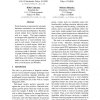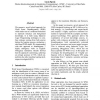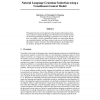50 search results - page 5 / 10 » Word Sense Induction Using Graphs of Collocations |
EMNLP
2006
13 years 10 months ago
2006
Word clustering is important for automatic thesaurus construction, text classification, and word sense disambiguation. Recently, several studies have reported using the web as a c...
ITS
1998
Springer
14 years 23 days ago
1998
Springer
This paper describes a method for learner modelling for use within simulation-based learning environments. The goal of the learner modelling system is to provide the learner with a...
BMCBI
2010
13 years 8 months ago
2010
Background: Word sense disambiguation (WSD) algorithms attempt to select the proper sense of ambiguous terms in text. Resources like the UMLS provide a reference thesaurus to be u...
ACL
2006
13 years 10 months ago
2006
We present a novel hybrid approach for Word Sense Disambiguation (WSD) which makes use of a relational formalism to represent instances and background knowledge. It is built using...
NIPS
2001
13 years 10 months ago
2001
This paper presents a novel approach to the unsupervised learning of syntactic analyses of natural language text. Most previous work has focused on maximizing likelihood according...



